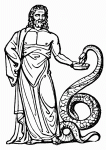01-31-2017, 04:42 AM
(This post was last modified: 01-31-2017, 05:11 AM by Michael Kerr.)
Just on the heavily armoured Sarmatian horsemen it does appear that although the various groups undertook their raids in winter to take advantage of frozen rivers it does appear that against disciplined infantry they did have problems in icy or wet conditions with their heavy armour and slippery conditions which made their cavalry ineffective.
The year before the Roxolani had no trouble wiping out two auxiliary cohorts and they still created havoc for a few years after their defeat on the ice.
Pausanius was describing what he saw on display at the Temple of Aesculapius/Asclepius in Athens. Aesculapius was the Greek god of medicine and was venerated with snake imagery.

It would not be surprising for someone to display Sarmatian armour with its reptilian look at the temple. As for Ammianus, I thought he was describing how some of the Alans fought in cuirasses made from smooth and polished pieces of horn. fastened like scales to linen shirts. The princes and the nobles probably had iron and hide armour.
The year before the Roxolani had no trouble wiping out two auxiliary cohorts and they still created havoc for a few years after their defeat on the ice.
Besides the defeat of the Roxolani while crossing the river with their loot as described by Tacitus we also have the defeat of the overconfident Iazyges by disciplined troops on the frozen Danube during the Marcomannic Wars by Cassius Dio. Strabo also refers to either Roxolani, Aorsi or Siraces mercenary cavalry units fighting for one of the various Pontic rulers, being defeated by Neoptolemus, Mithridates’ general near Kerch on the Sea of Azov just after the beginning of the reign of Mithridates the Great. Although there is no mention of armour it is obvious that the battle took place on the frozen sea and it looks like conditions didn't suit them.
Strabo then goes on to say that a few months later (I am not really sure which battle was first) Neoptolemus defeated the same enemy in the same spot in a naval engagement in Book 7,3,18 - It is said of Neoptolemus, the general of Mithridates, that in the same strait he overcame the barbarians in a naval engagement in summer and in a cavalry engagement in winter.
And Book 2,1,16 - The frosts are so severe at the mouth of Lake Maeotis that, at a certain spot where, in winter time, Mithridates' general conquered the barbarians in a cavalry engagement fought on the ice, he afterwards, in summer time, when the ice had melted, defeated the same barbarians in a naval engagement.Pausanius was describing what he saw on display at the Temple of Aesculapius/Asclepius in Athens. Aesculapius was the Greek god of medicine and was venerated with snake imagery.
It would not be surprising for someone to display Sarmatian armour with its reptilian look at the temple. As for Ammianus, I thought he was describing how some of the Alans fought in cuirasses made from smooth and polished pieces of horn. fastened like scales to linen shirts. The princes and the nobles probably had iron and hide armour.

Regards
Michael Kerr
Michael Kerr
"You can conquer an empire from the back of a horse but you can't rule it from one"
"You can conquer an empire from the back of a horse but you can't rule it from one"






